|

from
OpenSeti Webpage
Charles Hall's Millennial Hospitality
book series, describing his encounters with a race of human-like
extraterrestrials - the “Tall Whites” (TW) - during a two year duty
assignment at Nellis Air Force Base from 1965 to 1967, is a story
with tremendous visual impact.
Situated on Nevada's vast Desert
National Wildlife Range, a scenic wilderness containing almost no
artificial structures, the Nellis Ranges consist of almost nothing
but breathtaking scenery.
This is the backdrop against which Hall's story plays out. Every
event he describes can be said to consist of the same basic
elements: the landscape, the weather, the people (humans and
humanoids), the craft, sometimes the weather shacks... the
occasional glimpse of a hangar door and, believe it or not, the TW
children's playgrounds.
The story cries out for visuals of these elements. Yet it was not
possible for Hall to provide us with anything other than his
memories.
Visuals would have had value beyond the esthetic: they also would
have demonstrated the feasibility of some of the things Hall
describes. For example, he writes that he was able to view the Tall
Whites' main hangar entrance high in the mountains 30 miles north of
his Range 3 theodolite position on the desert floor. A photograph of
that unlikely view would have helped to support the story.
Twenty years after his discharge from the Air Force, Hall began
writing down his experiences, and after another twenty years,
published them - at first presenting his books as works of fiction.
Had he never reversed himself and begun claiming them to be true
stories albeit slightly modified to protect the identities of some
of the characters, there would have been no point in going back and
trying to reconstruct the events as they took place on the ground.
When he was writing his stories, he did not know that it might be
possible to reconstruct how they fitted into the landscape and in
that way test the possibility of what he claimed to have viewed.
He did not know that high resolution elevation data and satellite
imagery of the Nellis ranges would ever be made available to the
public, or that software capable of rendering photorealistic images
from the raw data would be widely available.
And yet, these things have come to pass, and this makes it possible
to create realistic illustrations and even a video animation of at
least one element of his story: the landscape in which it takes
place.
I first began experimenting with the geological data, the satellite
images, and landscape rendering software in late 2004, hoping to
have a first look at “geometric feasibility” and to add interest to
Hall's narrative.
The results were successful on both counts. In each instance, the
views described by Hall turned out to be confirmed by the graphic
renderings. And the images were pleasing and even dramatic to look
at.
One unexpected benefit from this work has been the opportunity it
has given Charles Hall to relive his old experiences through viewing
these illustrations. Here is what he wrote in an e-mail after having
been shown the report as a work-in-progress:
They are so impressive, I can hardly describe them. The memories
they bring back to me I am not able to describe in this short email.
Indeed, working with these images has given me the feeling that I
know the terrain well, and they can bring that closeness to you
also.
But what of the other elements that we would like to have: weather,
people, spacecrafts, and structures?
Here we are dependent on what Charles Hall remembers and is willing
to help us recreate in terms of drawings and verbal descriptions. He
has supplied two sketches of spacecraft shapes, and from this a
graphic model has been developed. This is included in the report.
Weather and lighting conditions are amply described in his books
where relevant, and it has been possible to recreate that aspect in
the landscape renderings.
Hall also describes the weather shacks in some detail, and they do
play a role in his experiences. I have elected not to take on the
task of rendering architecture in the present report, however, as
this would require significant additional effort, and it remains to
be seen if there will any interest in it.
As to the rest, we can hope that this report itself will stimulate
Hall's memories to the extent that he will be able to contribute
more information that can be included in future updates.
Airman First
Class Charles James Hall
Nellis Air Force Base with its associated "restricted ranges"
occupies more than 5000 square miles of southern and central Nevada
desert.
Nellis is a vast military reservation, home of "top gun"
flight training, exotic and leading-edge R&D projects. To the
civilian airman, Nellis lies under restricted airspace, which makes
it in effect a "no-fly zone".
To the rest of us, it is a no-man’s
land, a blank spot on the map, a black hole out of which no
information may come.
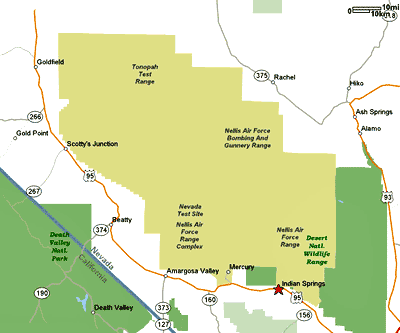
"click" image for
detailed information
That is, no information is supposed to come, although fabulous
stories have emerged over the years. Recently there has been a new
one, told by a one-time air force weather observer whose assigned
duty took him to a desolate outpost ninety miles northwest of Nellis
AFB proper, for extended periods between 1965 and 1967.
Today Charles James Hall is a nuclear physicist, actively employed
in Albuquerque, NM. In 1965-66, Airman First Class Charles Hall was
Range Weather Observer for several gunnery ranges. There was nothing
whatsoever exotic about his official duty assignment, and that is
what makes it possible for this story to be told today. Hall’s job
was to release and track weather balloons, measure the "winds
aloft", and call in reports to Nellis.
What was unique about his
situation was that as he was performing his weather observing
duties, he was almost continuously surrounded by a group of
extraterrestrials observing him. The beings would be in his weather
shacks, all over his equipment, even watching him shower in his
(otherwise-deserted) barracks, coming and going with complete
freedom.
This curious feature of his work was apparently never directly
discussed with his superiors. Did they know? Of course they did, and
they let Hall know that every person who had previously held that
assignment had been seriously attacked or at least warned away on
threat of death.
Over a period of seven years, at least 41 weather
observers had been compromised while trying to perform their duties
on the Nellis ranges. Some had required hospitalization and were
given medical discharges from the air force, and some had been
killed. Hall’s immediate predecessor in this position actually
deserted the air force and moved away from the area. His buddies
covered for him until the day of his actual discharge, when he
showed up to sign the papers.
On one occasion they even turned on Hall without warning, grievously
wounding him and leaving him to lie in the dust and die. In that
desperate situation, alone and miles from any Earthly help, Hall
conceived a way to save his own life.
Showing talent for being a survivor, Hall was eventually told he
could have that job as long as he wanted, and was offered an officer
track through the Air Force Academy and and an eventual permanent
assignment as Nellis Range commander (with time out for other
career-enhancing assignments).
Hall’s experiences were never classified but his orders were highly
classified. The reason for this mysterious arrangement is novel and
highly surprising. Hall’s own explanation is provided under
Correspondence in the sidebar at the left -- but it would be best to
read the rest of this page before looking at that, because you will
then be able to appreciate how it actually adds consistency to his
story.
Hall’s experience with the extraterrestrials at Nellis / Indian
Springs is too long and complex to be told here. He has published
the complete chronicle in his
Millennial Hospitality trilogy.
The books are presented as fiction, and Hall goes to great lengths
to fictionalize the locale as well as names of the characters,
including his own. However in current interviews, Hall now
acknowledges that the events described in the books are otherwise
factual.
To "decode" the story, simply apply the following:
|
Fictionalized |
Real |
|
Las Vegas |
Las Vegas |
|
Palm Meadows |
Las Vegas |
|
Desert Center |
Nellis |
|
Mojave Wells |
Indian Springs |
Salient Characteristics of the Tall White ETs
Hall has described these beings as tall
- ranging upwards of 6-7 feet in height - and quite thin and frail.
The skin color is chalk white. They are physically different from us
in several noticeable ways, yet the most important physical aspect
is that they are humanoid, a fact that is filled with significance.
Their life span is about ten times ours. They do not age as we do,
but after around 400 earth years' time they undergo a second stage
of growth, eventually reaching around nine feet in height. They die
of organ failure at an age of approximately 800 years.
According to exobiologists, extraterrestrials are not supposed to
resemble us, as they should have developed independently via natural
selection with randomness and varying environments leading to
innumerable "genetic" paths. On the other hand, some scientists
speculate that there will be resemblances due to the universal
utility of various aspects of the human form (i.e., what's good for
us should be good for everyone).
Meanwhile, a number of encounters known in the "UFO" field are with
entities that can look quite human - so much so that a deep
connection simply has to exist. The present case is one of these.
(See
Challenges to Darwinism
- Panspermia and Theories of Guided Evolution.)
The Tall Whites have a physical form similar to ours in all gross
aspects. That is, they are upright bipedal vertebrates; they have
human-like faces, etc. With suitable clothing, they can and do pass
as humans during well-guarded forays into Las Vegas.
Their life span is about ten times ours. They do not age as we do,
but after around 400 earth years' time they begin a second stage of
growth, eventually reaching around nine feet in height. They die of
organ failure at an age of approximately 800 years. The Tall Whites
have the faculty of speech, but some of their speech sounds are
outside the audible spectrum for humans. In other words, we can't
hear the sounds.
Normal speech sounds “like a dog barking or a meadowlark singing”.
However, some Tall Whites can mimic human speech and in fact carry
on normal conversations with humans. Some have demonstrated an
ability to imitate specific humans so well that the imitation cannot
be detected when used over a telephone.
They also can use a device that projects speech so that it is heard
by humans within their head. This works only over a short range
(several feet) and requires the human to turn the head sideways to
the Tall White.
The device is also a language translator. According to its settings
from time to time, Hall was occasionally able to overhear Tall
Whites conversing among themselves as though they were speaking
English.
As stated, there was a pattern of confrontations with our personnel,
in which panic led to injury and death of our soldiers. These beings
are all well-armed, and they can and do kill, sometimes at the
tiniest provocation. They react and move much more rapidly than
humans can, so if they decide you have threatened them, you may be
cut down and bleeding out without having even been warned.
Every Tall White adult carries a pencil-like weapon that can be set
to stun, kill, immobilize, or "hypnotize" humans. It can also
administer severe pain, and they frequently use it to discipline
people who act in ways that annoy, frighten, or endanger them. The
weapon's actions and effects are accomplished by varying the
frequency of focused microwaves to interact with specific ions in
the human body.
Although they can be friendly, they are at times arrogant and
insulting. They appear to be sensitive to our social structures
(i.e., classes), for example cultivating relations with high-ranking
military officials, some of whom were often seen working with them,
while holding lesser-ranking persons in disdain. Hall got along with
them by letting them treat him as their "pet", a term they used in
his presence.
In time, the term "Teacher's Pet" became Hall's code name that was
respected among the ETs and the ranking military who were aware of
his activities. He was selected by "both governments" to function as
the point man in a pilot program to explore paths of cultural
acclimatization between the tall whites and ourselves. Because of
everyone's tendency to panic, and the ETs to strike with their
weapons, Hall was awarded commendations for the rare bravery that he
exhibited during this period.
The Tall White group at Nellis have family structures, not unlike
our extended families. They often point out family members - uncles
and cousins, etc., - who are living and working with them on the
Nellis Base. They seem to care greatly for their children, who are
growing up and being educated out there in the sagebrush.
They have what we would call serious issues over "control". They
felt the need to control their pet, just as they observed us
controlling ours.
In all our fantasies of extraterrestrial contact, we probably never
imagined it would be like this. They are altogether too much like
ourselves for our own comfort. Is that cause to doubt the
authenticity of the story? Beware of that logic.
This aspect - that the Tall Whites deport themselves much as we
would when establishing a small base with family quarters in the
midst of a hostile land - deserves much more discussion. The point
has natural interfaces with other pages in Open SETI and will
connect to the Open SETI paradigm at several levels.
This will be addressed over time. (See
Open SETI At A Glance and also
Search Engine Results for "paradigm".)
Origin
-
A ripple of emotion passed
through the crowd when I mentioned the star Arcturus, some
36 light years away. After a short pause, the older lady
asked with some surprise, "Teacher, does Charlie know where
we come from?"
-
The Teacher replied, "No, not
quite, but he is close."
When asked where they came from, they
would usually evade the question by reminding him that he would not
recognize the name of the place if he heard them speak it.
This is disingenuous as they well knew
that we had our own names for many celestial objects and they could
use them as well as they could communicate anything else in English
to Hall. Typically they would laugh among themselves (in their
barking way) whenever they threw this response to Charles -- their
little joke on him. Charles wisely refrained from protesting.
In fact, they treated such topics as being what we would call
"sensitive". However, Hall, via the telepathic link they often
established with him, was able to perceive that the star Arcturus or
something close to Arcturus is very important to them.
Their ultimate home may be somewhere else. In recent correspondence,
Hall stated:
I was never able to determine which star the tall whites called
their home star. However, my best guess was a star that is roughly
105 light years away.
Hall's "best guess" was most likely an excellent guess, as he had
been able to figure out their route transit times from very careful
observations of the different craft and their schedules.
The date of their establishing the present Earth base location is
ambiguous. Hall received mental imagery suggesting they knew the
area prior to the arrival of European-Americans. Furthermore, one of
them suggested she had arrived here during the administration of our
President Madison. However the various bunkers and interior spaces
that Hall observed looked as though they had been built for the Tall
Whites by U.S. construction firms sometime in the 1950s.
Hall was led to believe that they use their Earth base as a sort of
waystation along lengthy interstellar travel routes, as though this
were the only intermediate station for them. As Hall puts it, our
solar system lies in the middle of a large open space that the Tall
Whites must traverse between their home location and a certain
distant destination.
But a glance at a table of distances to the closest stars from our
system puts that explanation in some question.
The Nearest Stars
|
distance
(l.y.) |
name |
|
4.22 |
Proxima Centauri |
|
4.35 |
Alpha Centauri |
|
5.91 |
Barnard’s Star |
|
7.70 |
Wolf 359 |
|
8.20 |
BD+36.2147 |
|
8.40 |
L-726-8A |
|
8.60 |
Sirius-A |
|
8.60 |
Sirius-B |
|
9.40 |
Ross 154 |
|
10.40 |
Ross 248 |
|
10.80 |
Epsilon Eridani |
|
10.90 |
Ross 128 |
|
11.10 |
61 Cygni |
Clearly there are many alternative choices for a base relatively
nearby.
This means that if it is even true that the Tall Whites must
have a base to use on the way from their home location to somewhere
beyond here, there still must either be something special about our
solar system and the Earth, or other choices are denied to them.
One thing that could be special is the simple fact that they like
the climate and environment of the Nevada desert and would not
consider any other place in our solar system. Not even another place
on the Earth, apparently. It is possible that they need conditions
that rather precisely match those of their home, and we are in no
position to guess how widespread or rare such may be. They may, for
example, require some trace element in our atmosphere.
At this point it is worth mentioning that
Michael Salla has been
thinking about what the more hidden purposes or activities of the
Tall Whites might be. Since we have at this time only the most
tangential information bearing on the purposes of the Tall Whites,
it is worthwhile for the reader in making his own evaluation to
examine Dr. Salla’s statements.
At any rate, if Arcturus or something close to Arcturus may be
significant in connection with the activities of the Tall Whites, it
would be well to review a little basic information about this star.
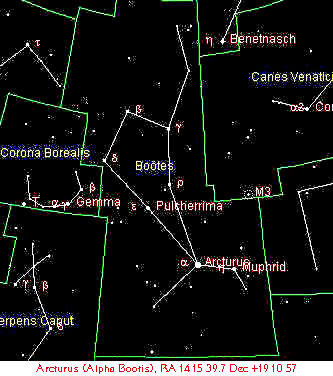
Arcturus, the alpha star of the constellation Boötes, is the fourth
brightest star in the sky. A spectral type K1 star, an orange giant,
Arcturus has ceased fusing hydrogen in its core. With 1.5 times the
mass of our Sun, it releases 215 times more radiation, a
considerable portion of which is in the infrared.
Boötes is one of the oldest defined constellations, having been
mentioned in Homer’s The Odyssey. This constellation has figured in
other contact cases.
The following image links to a 3-D view of the solar neighborhood
out to 50 light years. You will find Arcturus near the top, well
above the plane occupied by our sun. As you gaze at this lovely
image, ask yourself: Our solar system is the only possible base on
the way from Arcturus to WHERE?
Note that the map shows only the brightest 10% of the roughly 1400
star systems contained within this volume of space, but most of the
fainter stars are red dwarfs. Every G-type star is shown.
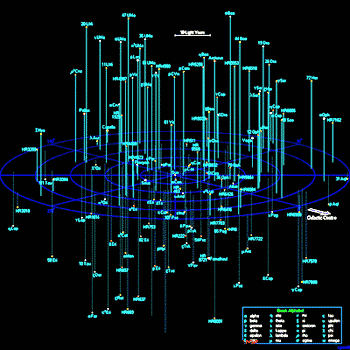
"click" above image
to see full catalog data on each star shown
The Tall Whites’ base seems to have a core of permanent residents
but also hosts transients, such as visiting scientists. While here,
they study such human behaviors as are available for observation
around Nellis.
Technology
The Tall Whites obviously possess highly-advanced technology.
Hall
confined his descriptions of their technology to brief discussions
of their deep space craft, the scout craft used for travel near the
earth's surface and around the solar system, a weapon that they
always carried, and special suits that afforded them limited
levitation and also a defensive force field.
Brief descriptions of the deep space and scout crafts are scattered
throughout Millennial Hospitality. From those descriptions and some
private communication with Charles Hall, simple details of the two
types of craft have been provided in the following table and figure.
|
|
|
|
|
|
|
|
|
|
|
|
|
2 large
centered 1/3 up from bottom
|
|
|
|
|
|
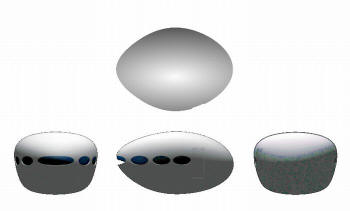
Orthographic views of generic scout craft according to Hall's
description.
3D model courtesy of Magda Gemis, Samuel Michelet, and Bruno
Michelet.
Hall also was able to catch at least a glimpse of a scout ship's
propulsion system, which appears to be based on “fiber optic coils”
with a very large number of windings. From his observations of this
system, Hall developed a physics theory that could describe its mode
of operation.
The deep space ships were capable of faster-than-light travel, and
could take the ETs to their home star system within two or three
months' time.
The scout ships, surprisingly, were assembled here on Earth with
components provided by humans for the ETs according to their
specifications.
From an interview with Michael Salla:
In book two I describe the afternoon
when The Teacher and Range Four Harry were showing me the inside
of one of the scout craft. Many of the items, such as the seats
and the overhead compartments, still carried the mold markings
placed on them by various American industries such as Boeing
aircraft and Lockheed corporation. The overhead compartments
were obviously "off-the-shelf" items from companies such as
Airstream corporation. Many of the clothing items that the tall
whites were wearing were obviously purchased straight out of the
Sears and Montgomery Wards Catalogs.
Yet these craft were capable of what appeared to be gravity-free and
massless operations and could accelerate to superluminal speeds (Open
SETI Physics 101). They were not as reliable in operation
as the aliens would have wished.
Hall noted a very important limitation of the propulsion system used
in these ships: its tendency to overheat, threatening the integrity
of its fiber optic coils. The need to minimize active propulsion
phases of interplanetary flights (i.e., earth approaches and
cislunar flight paths; little is known relating to interstellar
operations), leads the Tall Whites to make maximum use of ballistic
trajectories, and this in turn enabled Hall to correctly deduce the
times of scheduled earth arrivals and departures.
In his tour of the scout craft, Hall noticed two rows of
touch-sensitive buttons just inside the door. Significantly, they
bore cartouche-like symbols, Egyptian-style except with more
pictorial elements in them than typical cartouches would have.
Hall notes that touch-sensitive buttons were just beginning to
appear in human-made systems at that time.
And incidentally, the scout craft buttons were not the only example
of hieroglyphs or cartouches encountered by Hall. He describes
having found a hangar door open one day, with no one guarding, so he
took the opportunity to go a short distance inside. He found the
walls to be covered with cartouches, oddly colored pink against a
white background.
Information about Tall White technology is scattered throughout the
Millennial Hospitality series. An ongoing program of technology
transfer is described in MH III and in the Karmapolis interview.
For more information about their technology, please refer to the
published books and to material available at various websites (see
links at right).
Where Was/Is the Base at Nellis?
It has been possible to reconstruct views of the locations of Tall
Whites' operations and facilities according to Charles Hall's
recollection.
Although readers will not be able to verify this
information on the ground, it still seems useful to go through this
exercise in hopes that it may aid in the overall evaluation of the
case and the situation, to say nothing of enhancing the sense of
place in a way that text alone cannot provide.
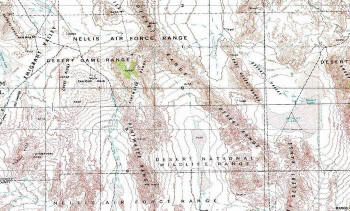 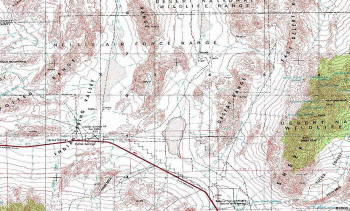
It has been possible to reconstruct views of the locations of Tall
Whites’ operations and facilities according to Charles Hall’s
recollection.
Although readers will not be able to verify this
information on the ground, it still seems useful to go through this
exercise in hopes that it may aid in the overall evaluation of the
case and the situation.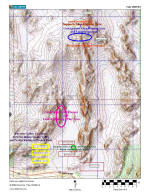
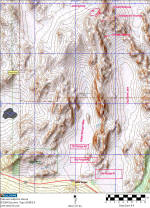
To set the scene, here are two overhead views of the area.
The first
image (below-left) indicates the general location of facilities in the north: the
hangar entrance used by the deep space ships; and the housing
facility, situated inside the Pintwater Range; a landing area and
"back door" tunnel entrances to the northwest.
This is actually
slightly incorrect; the tunnel entrances should have been placed
farther to the east, in the mountain proper. Gunnery and bombing
ranges that figured in Hall’s story are also shown.
Hall is aware of at least seven entrances concealed in the mountain
canyons. The main entrance to housing is through the hangar on the
east side of the mountain range. (image
left)
The next view was an earlier graphic construction which did not
include French Peak on the west; it also lacked labels on the main
valleys. However Hall has added important new data to this image.
A
composite of these images will be placed here when it becomes
available. (image above right)
Facilities and
Activities
Numerous facilities and activities within the Pintwater Range and
the prominent dry lake in Three Lakes Valley, known as “Dog Bone
Lake”, will be described.
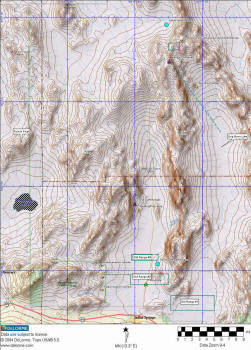
Relief view of area
encompassing Tall White activities
Hall is aware of at least seven entrances concealed in the mountain
canyons.
The main entrance to housing is through
the hangar on the east side of the mountain range, top right in the
above chart. Notice the three gunnery and bombing ranges located
just north of the Indian Springs area. Hall made use of “weather
shacks” located on each range. The position of the theodolite at the
Range Three weather shack is shown.
Hall writes (personal
communication):
The tall whites had at least 5 areas
of interest visible from the Range Three theodolite stand.
These five areas included:
1)
The main base and its deep space
craft hangar located northwest of Dog Bone Lake. It had an
associated children's playground...
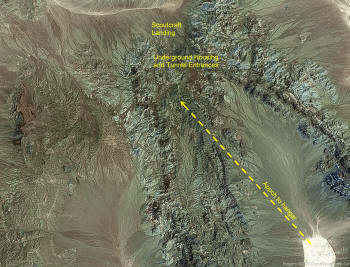
Tall White
facilities and deep space craft final approach path to the
hangar at the northern end of the Pintwater Range.
Image courtesy of
Google Maps®. A pilot's eye video of the approach has been
provided farther down on this page.
Arriving deep space craft were
observed to first hover or land at Dog Bone Lake near the upper
end of Three Lakes Valley, then to proceed northwest to the
hangar entrance, which is built into a mountainside.
Arrivals always occurred at sundown,
full moon.
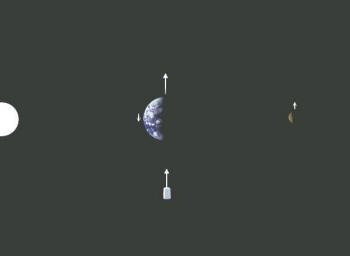
Sun-Earth-Moon
configuration for approach of deep space craft.
This is a rough
two-dimensional representation. Sizes and distances are not to
scale.
Hall observed
that arrivals always occurred at sundown on full moon days.
Hall believes that this
configuration, with the sun on one side of the earth and the
moon on the other, and the earth moving away from the
approaching craft, provided the “smoothest” gravitational field
through which the craft needed to maneuver.
This might have been an
oversimplified explanation, yet clearly, with the crafts'
propulsion units' tendency to overheat, the Tall Whites were not
free to choose any arbitrary entry into the earth-moon system.
They needed a path that minimized the required use of the
propulsion system. It is also possible that the craft were
hand-navigated on the approaches and that this factor played a
role.
Deep space craft departures took place at midnight at the time
of the new moon.
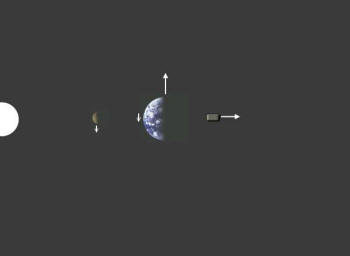
Configuration for
deep space craft departures. Not to scale.
Hall observed
that departures to deep space always occurred at midnight at the
time of the new moon.
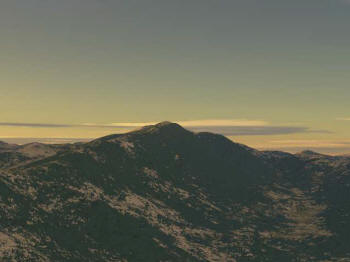
Arriving deep
space craft proceed northwest, along the line of sight viewed in
this image, from Dog Bone Lake to this peak.
The hangar, which
is also the main entrance to the Tall Whites' underground
housing,
is built into the
top of the peak; its entrance is just below the top, facing
south, approximately
where a patch of
sunlight from the setting sun can be seen.
Approaches are
made at sundown on full moon evenings
2) The
main underground alien housing area with its tunnel entrances
and associated children's'
playground....
Let's stop and investigate how much of this main northern
facility can be seen with Hall's theodolite, positioned as it
is, some 30 miles to the south.
There are two considerations: does the terrain profile permit
this view, and what would be the effect of the telescope's
optics and magnification?
Addressing the first question, the next image shows the viewing
path from the theodolite up the valley. Clearly the valley is
relatively flat and the high terrain in the distance would seem
to be unobstructed.
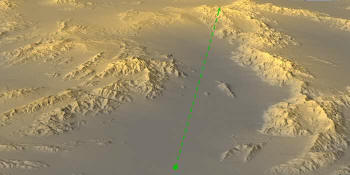
3D view of
terrain looking from theodolite position toward the facilities
thirty miles north at the north end of the valley.
Dog Bone Lake is
in valley to the right (east).
The next image is a landscape render
of the ground-level view from the theodolite stand, showing that
much of the high terrain to the north is indeed visible.
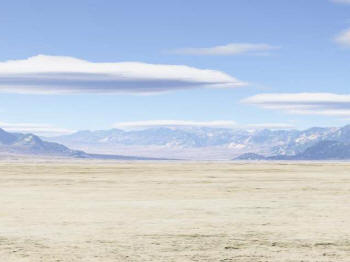
Ground-level
(elevation 2 m) view from the theodolite position toward the
high ground at the north end of Indian Spring Valley.
In other words,
this is the view along the green dotted line in the previous
image.
The peak
containing the main hangar and housing is faintly seen on the
distant skyline to the right of center.
This image
provides no information on land use (roads, etc.).
[The above image] is so well done, I
found myself reliving some of those beautiful afternoons when I
took my truck for a joy ride up the valley.
When you look at the center of the picture , and then a little
to the right, right down on the desert where the desert floor
meets the base of the distant mountains, just behind the near
set of hills and just far enough to the right so that the near
set of hills does not block the view of the more distant
mountains, there is a small valley.
It was in that valley that
the Tall Whites would typically post a scout craft to parallel
me and watch me from a distance whenever I would take my truck
up the valley for a joy-ride... as I describe in Book II, in the
chapter entitled "Day with a view".
We will return to this point later. This watching of Hall on his
trips north could have been for his protection, as at one point
he had a nearly disastrous encounter with a government security
patrol on one of these excursions.
As to the effect of the telescope's
optics and magnification:
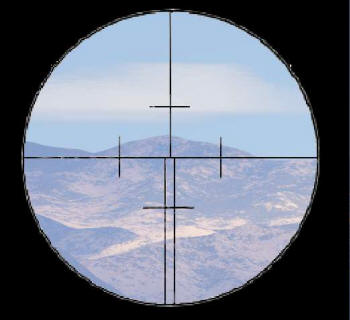
Deep space craft
hangar and underground housing area
as seen from
range 3 theodolite position through typical theodolite scope
with 1.5° field of view.
Distance is about
30.5 miles.
“I was shocked by
the accuracy of [this image], the view through the theodolite.
On many, many
summer mornings, those mountains looked just that way through my
theodolite.”
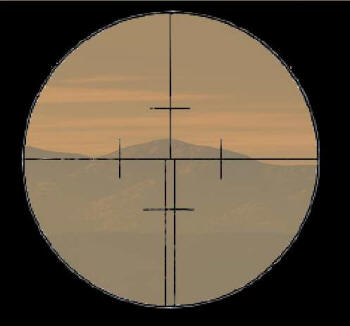
Similar to
previous figure but “taken” just before sunset.
Hall mentioned
that his ability to see the hangar and picnic area on this
mountain was best just before sunset, as here, and just after
sunrise.
Nevertheless 30
miles of obliquely-illuminated haze does seem to be causing a
problem with seeing in this rendition.
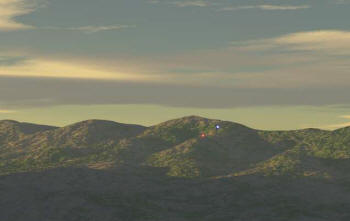
The peak
containing the hangar, viewed along the line of sight from
the Range 3
theodolite (which was Hall's usual viewing position), but only
4.2 km from the peak.
The time is just
before sunset. The blue/white star marks the position of the
hangar entrance.
The red/white
star designates the location of a picnic area (!) which is what
first caught Hall's attention.
The hangar door
was hidden among the trees and was hard to spot (through the
theodolite from 30 miles away) when closed.
Note: the
landscape renderings on this page do not actually depict trees.
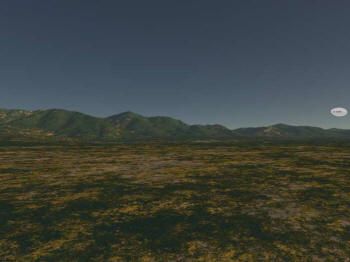
Departure of
scoutcraft from an important landing area northwest of the main
housing area which is under the mountains.
View is toward
the southeast at dawn,
the time of day
when Hall observed scoutcraft departing with military guests for
visits to the moon,
which would be
directly overhead.
Canyons in these
mountains contain at least seven concealed tunnel entrances -
back doors to the underground housing.
3)
Their favorite scout craft hangar and underground rest area
located in the arroyo just northwest of the dry lake bed on
which sat the old Range Four. It had an associated children's
play ground....
This facility can be located at the very top of the following
image.
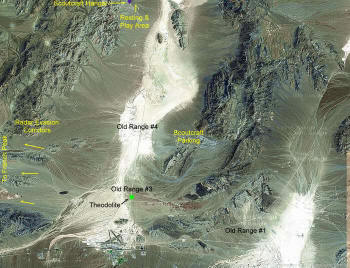
This satellite
image shows the locations of the gunnery and bombing ranges,
scoutcraft hangar, playground,
and other Tall
White activities at the southern end of the Nellis Range.
Image courtesy of
Google Maps®.
Notice the "Scout-craft Parking" area
in the middle of the above image. This was a sheltered area in
which Hall often saw a scout craft "parked" when he drove by,
headed north.
The next image shows the situation a
bit more clearly...
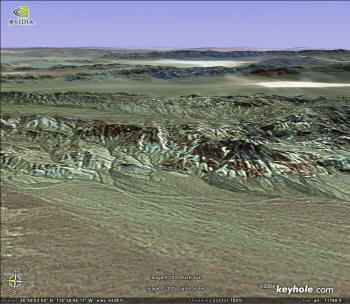
The road running
north-south (note the compass rose) at the foot of the hills was
used by Hall on his excursions to the northern end of Indian
Springs Valley.
He often would
see a scout craft parked in the little valley to his right, in
the center of the picture, observing him as he passed by.
The craft would
then follow or “parallel” Hall's truck from a distance
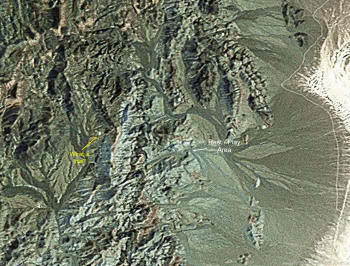
A closer overhead
view of the favorite Tall White rest and play area.
An anomalous
white object or spot can be seen at left center (i.e., over
rough terrain to the west).
Parallax studies
indicate that this object is on the ground.
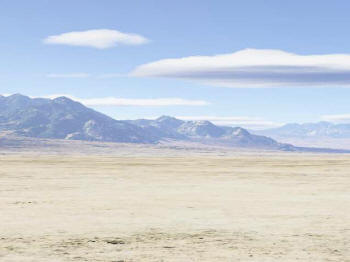
View toward the
rest and play area from the Range 3 theodolite position.
The area is
concealed between the two fingers of high ground in center of
picture.
...had its hangar door dug into the southern side of an
east-west arroyo.
View looking west into the arroyo:
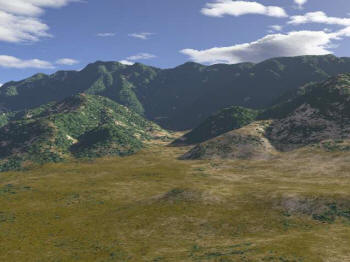
Looking west into
the Tall Whites' favorite rest and play area.
A scout craft
hangar was built into the south (left) wall of this canyon area.
"Another
shockingly good rendition.
It sure brings
back the memories.
However, there is
an additional arroyo that [this figure] does not show becasue of
the resolution.
It runs through
the center of the valley.”
This image was
prepared from 1/3 arcsecond-resolution elevation data.
4)
Two other scout craft hangars and underground rest areas with
associated children's play areas located in the lower mountains
in the northern parts of the Indian Springs valley. These two
are not otherwise described in my current books and writings.
One of them appeared to include additional food storage and
processing facilities but I'm not certain of the details.
In an e-mail to Dr.
Richard Boylan, Charles
Hall stated,
"In the 1965-1967 time frame, I
personally and frequently observed on many separate
occasions the tall white scout craft and the tall whites
entering and leaving the valley just below French Peak.
Several of the range maintenance men at that time informed
me that the tall whites had at least a scout craft base dug
in toward the top of French Peak."
He also writes (in other
correspondence):
I'm not certain where the scout
craft hanger on French Peak is located. However, my friends
reported seeing the Tall Whites gathering grass seeds and
other seeds in the fall, on the mountains that I have
circled in red.
Sometimes, I also saw scout craft in the valleys below that
area.
Several of the other scout craft hangers in the northern end
of the Indian Springs valley were hidden down in narrow
east/west valleys with steep sides. For these reasons, I,
myself, would look for the scout craft hanger inside of the
red ellipse as well.
View of French Peak from the south.
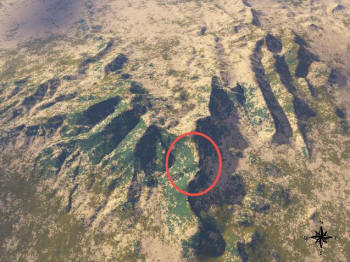
French Peak.
Text describes
Tall White activities in the area enclosed by the ellipse and
the broad valley to the north.
In addition, the map shows the
entrances to the Indian Springs valley on the west (in yellow,
etc.) which the tall whites liked to use when they were
traveling between Indian Springs Valley and the valleys that
lead up to French Peak. They used these corridors sometimes on a
daily basis.
Remember these corridors allowed them to safely travel from
place to place without showing up on the FAA radar screens. I'm
certain they terrain-followed these corridors up to the base of
French Peak.
As Hall has explained, while their presence at Nellis was
sanctioned at high levels, the Tall Whites maintained a very low
profile, and tried to avoid unnecessary radar detections of
their craft when operating in the ranges. Hall describes “radar
evasion corridors” used by the Tall Whites' scout craft
transitioning between the lower Indian Springs Valley (near
Range 3) and the area south of French Peak.
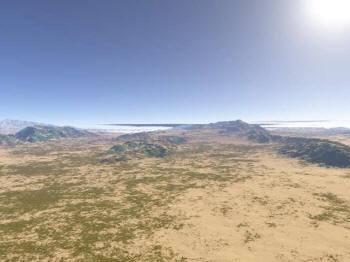
View west into
"radar evasion corridors" used by the scout craft.
This is as they
would be seen from an elevated position near Range 3... in other
words,
a “pilot's eye”
view of the parallel ridges.
Craft would
“terrain follow” just north of these ridges below the ridgeline
to avoid
detection by radar on Charleston Peak, well to the south.
The next image shows the configuration of Charleston Peak, the
theodolite positions for ranges 1 and 3, and the radar evasion
corridors.
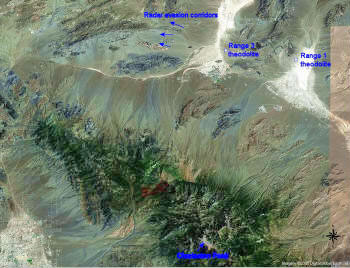
The radar station
of concern to the Tall Whites is installed on Charleston Peak,
a recreational
area to the south of the ranges.
The ski area,
seen as a small white blotch at the tip of the labeling arrow,
plays a crucial
role in the Christmas Eve emergency arrival of a deep space
craft, to be described below.
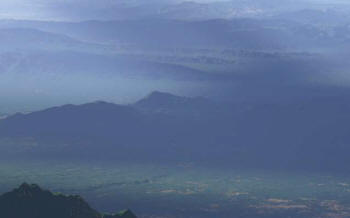
Radar evasion corridors as seen from just over Charleston Peak
where radar is located.
Scout craft would
“terrain follow” behind the low ridges seen in the distant haze,
beyond the foreground ridge and to the right of center.
“I was equally impressed by this
figure. It clearly shows why the Tall Whites preferred to
terrain-follow close to the desert and hide in the radar
corridors.”
Some of my friends who were range
maintenance men said they had observed the tall white scout
craft continuing on up the sides of French Peak to another scout
craft hangar entrance up towards the top.
Christmas Eve
Emergency Arrival of a Deep Space Craft
An important episode in Hall's story dealt with his role in
facilitating the arrival of a severely damaged Tall White craft from
deep interstellar space.
From the evidence, it appears the problem with the arriving craft
had been known by the local Tall Whites and by our military for at
least two months.
As in so many of his encounters at Nellis, the landscape itself
played a significant part. Hall's actions took place at Ranges 1 and
3, while the craft itself made its initial arrival at a ski
development on Charleston Peak, which became a base for the
operation, after being evacuated for this purpose.
The last two figures in the previous section, shown in connection
with the “radar evasion corridors”, along with the figures in this
section, demonstrate the geometry of the landscape underlying this
event, and show what can be seen from each of the ranges.
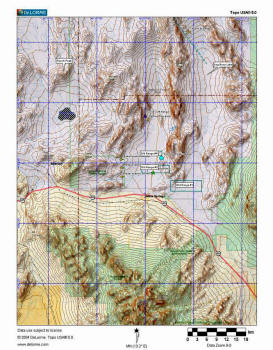
Topographic map
depicting the ranges and Charleston Peak to the south.
Note that Range 3 is
almost directly north of Charleston Peak, providing a direct view
into the base area.
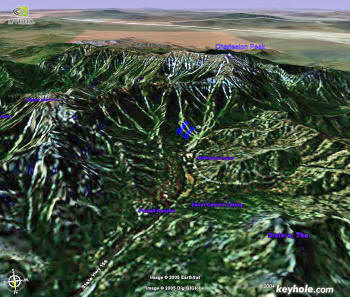
Charleston Peak viewed along the bearing from Range 3 (note the
compass rose),
exposing the base
facilities of the ski area.
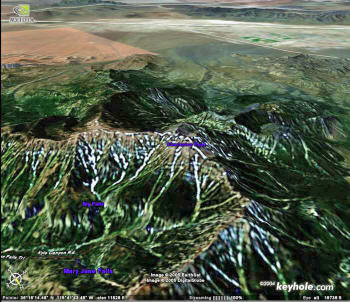
Charleston Peak viewed from the bearing along which lies Range 1.
This Keyhole® image
clearly shows the ski runs. Coordinates are shown at bottom.
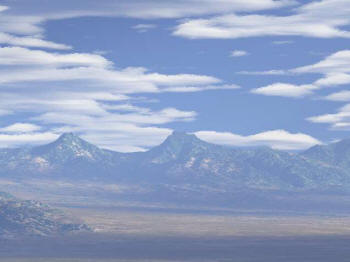
Charleston Peak from Range 1 (ground level).
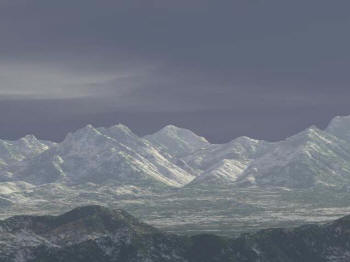
Charleston Peak (center rear) viewed from Range 3, early December.
Hall facilitated the
arrival of a disabled deep space craft that briefly used ski area
base facilities.
“This is another
shockingly impressive view from the Range #3 theodolite.”
Children of the Tall Whites
Notice the reference to playgrounds at virtually every Tall White
facility. In fact, Hall’s weather shacks were playgrounds for the
Tall Whites’ children. He especially endeared himself to them by
leaving his theodolite open and allowing the children to look
through it whenever they wished.
In one of his radio interviews, Hall mentions that "The Teacher’s"
constant refrain was "We love our children more than you do," and in
fact if you know what’s good for you, you will open every
conversation with a Tall White female by saying "I know you love
your children more than we love ours."
In his
interview with
Salla, Hall mentions:
One of the big items [supplied to the Tall Whites by the US
military] was children’s clothing. In the mid 1960s, on at least one
occasion, the USAF purchased more than $600,000 [1965 dollars, as
one of Salla’s readers points out!] worth of children’s clothing
from the Sears stores and warehouse in Los Angeles, California,
picked it up in government trucks, and shipped it to Indian Springs
Auxiliary Field, Nevada. The trucks delivered the clothing to the
main Tall White base at the north end of Indian Springs Valley.
Let’s do a bit of arithmetic. A children’s "outfit" today might sell
for around $75. That might be equivalent to, say, $15 in 1965. Very
roughly, the shipment then might have contained some 40,000
"outfits". A child might have required, say, three outfits for their
wardrobe at one time. But our children outgrow their clothing. So
would those of the Tall Whites.
Furthermore, since the TWs in
general live ten times as long as we do, their childhood years might
also run ten times ours. Therefore if an Earth child, outgrowing
clothing from time to time, might go through or wear out some five
sets of clothes, then each Tall White child ultimately speaks for 3
x 5 x 10 = 150 outfits. That means the order would have equipped
some 250-300 children with their clothing needs.
It would be useful to determine how many children were present in
the colony. If there were significantly fewer than 250 children,
this would suggest that some of the clothing was for use elsewhere -
either elsewhere on the planet or off.
In a letter, Hall
indicates that the number of children present may have fluctuated
greatly over time, but could have occasionally exceeded 200.
Since there was considerable flux into and out of the colony,
children could have been taking their "Earth outfits" with them when
they left.
To further help understand why there had been a single large
purchase, I asked Hall if the body build or anything else about the
TW children would have required special tooling on the part of the
manufacturer. That could have helped to explain the large size of
the order, as the manufacturer would have needed a large order to
cover the retooling cost.
Here is Hall’s reply:
As regards the children’s clothes question, remember that
Sears made
and marketed children’s clothes in every conceivable size and
variation. The TW children were the same size as human children of
the same height who are simply on the thin side.
Clothes for the TW children did not have to be specially made.
Remember also that the TW mothers also make and alter clothes for
their children, just as human mothers do. One night, in an episode
that does not appear in my books for various reasons, The Teacher
came with her little girl. Her little girl was wearing a simple
frill [flounce] around the waist of her suit similar to the type of
frill that little girls typically wear on their bathing suits.
The Teacher proudly informed me that she had added the frill
(meaning that she had personally constructed the frill and added it
to the suit - sewing, etc.) because she wanted her little girl to
feel like a little girl.
The Teacher occasionally expressed concern because all of her little
girl’s TW playmates her age were boys.
She stated, for example, that one reason she liked to have her
little girl play with the little girl described in Book one in the
Chapter entitled "In Remembrance Of ME" was because she wanted her
little girl to have playmates who were also little girls. The TW
little girl and the human little girl were so very similar in
personality. They were both simply "little girls", even down to the
clothes they both enjoyed wearing.
It must be said: perhaps the TWs had good reason for doubting how
much we love our children. Consider what they might have observed of
our everyday life down there around the base and in Las Vegas.
To which I might add that the story, The Wayward Wind, reproduced on
Paola Harris’ page, shows how the TWs were overwhelmingly impressed
by Hall’s letter to his father, expressing love for him.
This little note to Hall’s father was so very important to the
TWs
that - who knows? - it might have affected our relations with them
then and into the future.
Several notable points come to mind here:
-
They sew. We apparently share a sense of fashion with them.
-
Where are all the little Tall White girls? Little TW girls must
exist somewhere because TW adult females are present in the colony.
Why did they not come here?
-
They evidence "love" among their own kind; little for us. But then,
where have we shown anything resembling love for them?
Tall Whites vs. Gods,
Genes, and Consciousness
The recently published
Gods, Genes, and Consciousness (Von
Ward, 2004) is currently being discussed in the
Open SETI Forum (II) on Gods, Genes, and
Consciousness.
Since the "tall whites" contact case is
the first one to be extensively addressed in Open SETI, and
since Von Ward's schema as presented in his book could be
used to help understand human reaction to ALL contacts, it would be
worthwhile for the reader to check that forum and that topic.
Participation, furthermore, is highly encouraged.
The Tall Whites represent an interesting application of Von
Ward's term Advanced Being (AB). Although their
technology is quite beyond ours at this time, evidence suggests that
by other and less tangible measures - "wisdom", "intelligence",
"moral stature" - they might be quite comparable to ourselves.
This subject merits much discussion, It
is hoped that it will be taken up in the Forum.
Conclusion
This report never seriously questioned the authenticity of Charles
Hall's contact with a colony of “Tall White” extraterrestrials on
the Nellis Range. The reason for that is the generally convincing
nature of Hall's reporting, however subjective that assessment may
be.
If a “scientific study” is required,
others may conduct one.
This editorial stance is consistent with the position taken
throughout this Open SETI Initiative website, in which I
assert that “contact with ET” or even “searching for ET” should
never have been left in the hands of the scientific establishment in
the first place. It is unlike anything that science normally does;
it is more a matter of intelligence gathering, which is probably the
way the most productive work in this area has been accomplished.
This report is exactly what it claims to be: an illustrated adjunct
to Hall's narratives.
Nevertheless, if in the process of preparing this report, I had
encountered issues or contradictions calling Hall's story into
serious question, then certainly those problems would have had to be
resolved before the report could be completed and published - at
least in its present form.
Nothing of the kind has happened.
The next question is to consider where that leaves us. There was, as
recently as the 1960s, a well-established and possibly very old
colony of extraterrestrial humanoids living on the Nellis Range, and
at that time the arrangement appeared to be secure for long into the
future. Furthermore the relations of the colony with its present
hosts - the U.S. Military and government - were congenial;
technology transfer was taking place and larger cooperative programs
(which seemed benign to all parties, by the way) were contemplated.
Hall believes that the arrangement continues to this day, although
he has had no contact with it since leaving active duty.
The parameters of the contact activity or colony are such that it
would have zero impact on our society, other than the filtering down
of anything resulting from technology transfer. It seems to have
been physically confined to the military reservation, although there
are troubling aspects, such as what is being done with all of the
scout craft based there. Where are they going and what are they
doing?
Hall's books and interviews have been available to the public for
several years, and have made no impact whatsoever outside of a
community of interested cognoscenti. Certainly this report will not
materially change the situation.
One would think, given the general lack of interest in this sort of
thing on the part of average citizens, that nothing whatsoever is
called for in the way of a response to these reports.
On the other hand, even with no more information than we have
available through Hall's books, the research value of the details
reported by Hall are immense... immeasurable. The mere knowledge
that beings from such distant points of origin can so closely
resemble us is enough to cause a revolution in our life sciences,
particularly biochemistry and genetics. That is, it would be enough
if correctly used.
Consider also the implication of the close cultural correspondences,
such as the ability of these beings to recognize and work with our
social hierarchy. “Take me to your leader”, indeed.
The parallels with our own culture are... either breathtaking or
damning, depending on whether one believes they can possibly be
true. This... familiarity of their cultural (and physical) styles is
actually one of the largest challenges to the story, because so very
much rides on it.
My position is that it is true and we would do very well to begin to
try understanding what it means.
Epilog: A
Possible Identity for the Tall Whites
-
Who are the Tall Whites?
-
What do we mean by that
question?
-
We mean: what group of beings,
about whom we may have independent knowledge, might the Tall
Whites be?
In fact, there is a candidate group. In
our report on the work of French writer Anton Parks,
Les Chroniques du Gírkù / Notes, we
describe a number of nonhuman races that seem to have shaped our
history and genetics, and are possibly influencing or manipulating
human society even today.
One of these, the Imdugud, known to the
Babylonians as Anzu, actually are native to our solar system. They
are not the famous "Anunnaki." In fact they long ago lost a war
against the Anunnaki for the mastery of this system.
Among the interesting matching characteristics of the Tall Whites
and the Imdugud:
-
Very tall humanoid "Nordic" with
white skin
-
Often have blue eyes
-
Emit barking or whistling sounds
-
Solitary
-
Warriors/soldiers
Parks adds in private communication that
the Imdugud are among the very few that practice natural childbirth
and raise families. (Most use genetics and cloning, and take
advantage of very long or indefinitely long life spans. In other
words, they are immortal.)
Yet there are contradictions, perhaps the most noteworthy being
their apparent home base. Although the Tall Whites would never
reveal this information to Charles Hall, they allowed him to believe
it was not local, and via circumstantial data Hall has placed their
home tentatively at the star Arcturus. However, it is also possible
that Arcturus is simply another base - a "second home."
Parks "remembers" that as of three or four thousand years ago, our
solar system was their home base. Although they could always travel
out, it was not their preoccupation to do so.
We will be tracking this new development. Meanwhile, interested
readers should look at
Possible Extended Contact with Imdugud,
or find mention of Imdugud(Anzu) in the
section on Races.
|

































